The AMD Ryzen 5 2500X and Ryzen 3 2300X CPU Review
by Ian Cutress on February 11, 2019 11:45 AM ESTCPU Performance: Office Tests
The Office test suite is designed to focus around more industry standard tests that focus on office workflows, system meetings, some synthetics, but we also bundle compiler performance in with this section. For users that have to evaluate hardware in general, these are usually the benchmarks that most consider.
All of our benchmark results can also be found in our benchmark engine, Bench.
PCMark 10: Industry Standard System Profiler
Futuremark, now known as UL, has developed benchmarks that have become industry standards for around two decades. The latest complete system test suite is PCMark 10, upgrading over PCMark 8 with updated tests and more OpenCL invested into use cases such as video streaming.
PCMark splits its scores into about 14 different areas, including application startup, web, spreadsheets, photo editing, rendering, video conferencing, and physics. We post all of these numbers in our benchmark database, Bench, however the key metric for the review is the overall score.
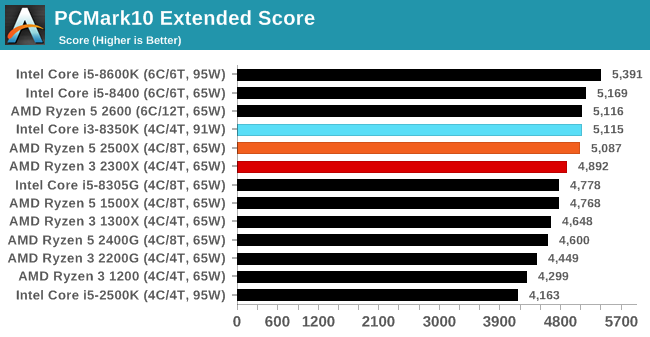
PCMark likes a lot of single threaded performance, and the quad-core Core i3 matches the eight-thread AMD, with the quad-thread AMD just slightly behind.
Chromium Compile: Windows VC++ Compile of Chrome 56
A large number of AnandTech readers are software engineers, looking at how the hardware they use performs. While compiling a Linux kernel is ‘standard’ for the reviewers who often compile, our test is a little more varied – we are using the windows instructions to compile Chrome, specifically a Chrome 56 build from March 2017, as that was when we built the test. Google quite handily gives instructions on how to compile with Windows, along with a 400k file download for the repo.
In our test, using Google’s instructions, we use the MSVC compiler and ninja developer tools to manage the compile. As you may expect, the benchmark is variably threaded, with a mix of DRAM requirements that benefit from faster caches. Data procured in our test is the time taken for the compile, which we convert into compiles per day.
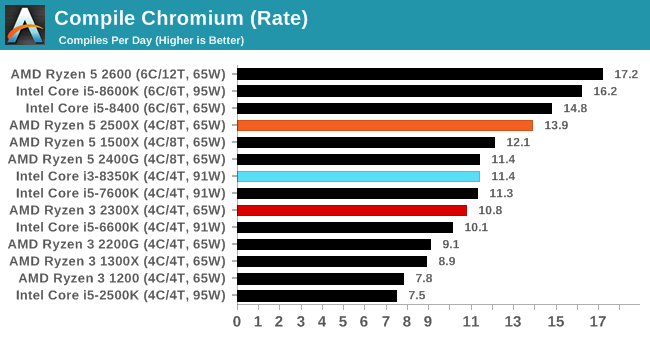
In our compile test, the higher thread count of the 2500X gives it a good lead over the other two comparison points, although the 2300X is only slightly behind the Core i3 here.
3DMark Physics: In-Game Physics Compute
Alongside PCMark is 3DMark, Futuremark’s (UL’s) gaming test suite. Each gaming tests consists of one or two GPU heavy scenes, along with a physics test that is indicative of when the test was written and the platform it is aimed at. The main overriding tests, in order of complexity, are Ice Storm, Cloud Gate, Sky Diver, Fire Strike, and Time Spy.
Some of the subtests offer variants, such as Ice Storm Unlimited, which is aimed at mobile platforms with an off-screen rendering, or Fire Strike Ultra which is aimed at high-end 4K systems with lots of the added features turned on. Time Spy also currently has an AVX-512 mode (which we may be using in the future).
For our tests, we report in Bench the results from every physics test, but for the sake of the review we keep it to the most demanding of each scene: Cloud Gate, Sky Diver, Fire Strike Ultra, and Time Spy.
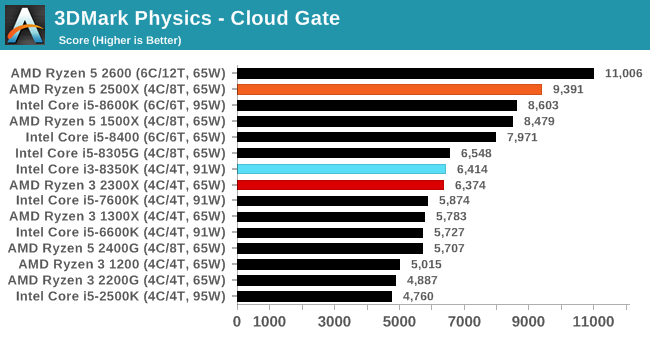
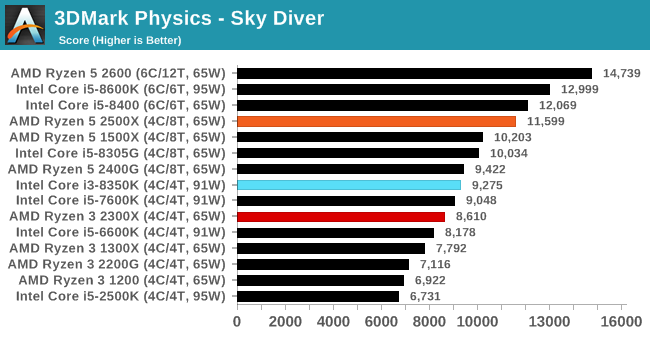
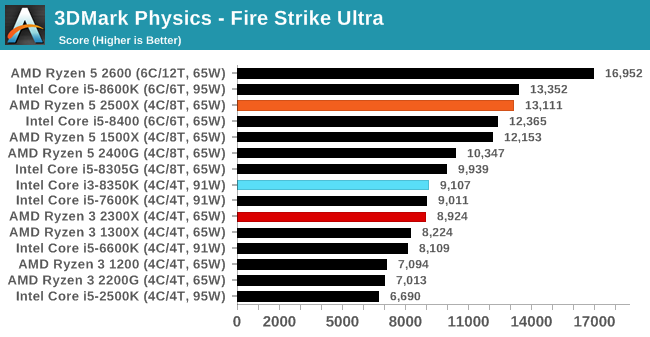
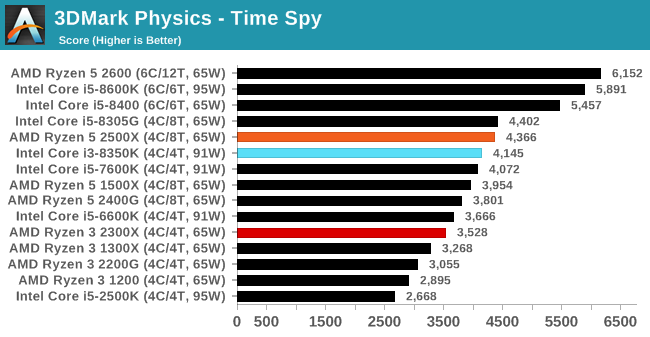
GeekBench4: Synthetics
A common tool for cross-platform testing between mobile, PC, and Mac, GeekBench 4 is an ultimate exercise in synthetic testing across a range of algorithms looking for peak throughput. Tests include encryption, compression, fast Fourier transform, memory operations, n-body physics, matrix operations, histogram manipulation, and HTML parsing.
I’m including this test due to popular demand, although the results do come across as overly synthetic, and a lot of users often put a lot of weight behind the test due to the fact that it is compiled across different platforms (although with different compilers).
We record the main subtest scores (Crypto, Integer, Floating Point, Memory) in our benchmark database, but for the review we post the overall single and multi-threaded results.
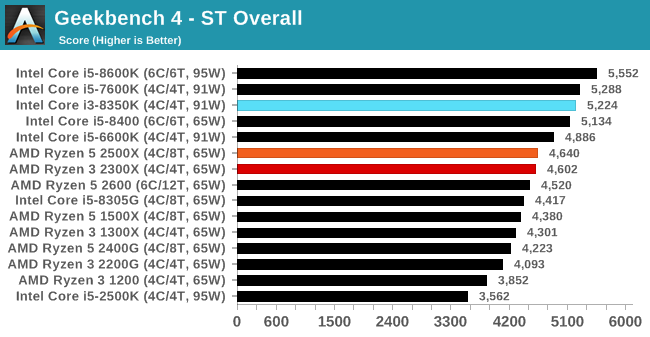
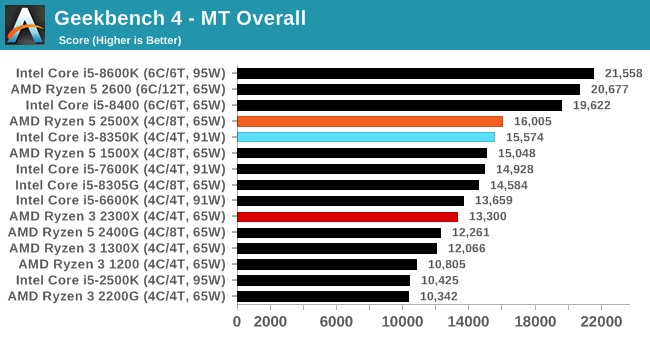










65 Comments
View All Comments
romrunning - Monday, February 11, 2019 - link
It may just be me, but all of the links on the "Pages In This Review" at the bottom of the main page simply return me to the main page.romrunning - Monday, February 11, 2019 - link
But the drop-down to the specific page works as expected.evilspoons - Monday, February 11, 2019 - link
It's definitely not just you. I spent a few tries wondering what I was doing wrong and re-read the start of the article until I tried the drop-down menu instead of the links.Ian Cutress - Monday, February 11, 2019 - link
That's my fault, as the hyperlinks need to be manually added. I had messed up the part of the URL after the /show/13945. It should be fixed now.Kevin G - Monday, February 11, 2019 - link
I noticed this as well.IGTrading - Monday, February 11, 2019 - link
Thank you Ian for a good review.I completely agree with the conclusion that the 2300X makes perfect sense, but the 2500X is harder to place in the picture ...
On the other hand, despite 2400G and the 2500X have the same TDP, if I look at the graph with full load power consumption, I can clearly see that the latter has a very generous thermal limit, compared with the 2400G where the thermal envelope seems to be very strictly limited.
Meaning OEMs will probably be able to use the 2500X for cheaper gaming systems where auto-overclocking is used as a feature and AMD will thus be able to offer something better for a lower price.
This also allows AMD to push AM4 harder on the market, giving itself the opportunity to future upgrades for AM4 buyers.
So the 2500X will show considerably better performance than the 2400G despite the similar config (minus the iGPU) while not cannibalizing the 2600 nor the 2400G.
If AMD manages to sell more 2500X through OEMs, AMD also builds a future upgrade market for itself, unlike Intel that will likely push buyers into purchasing new machines.
dromoxen - Monday, February 11, 2019 - link
ppl buying these CPUs are not the sort to be upgrading the CPU.. to most the computer is a closed box and is upgraded as a whole . I do wonder where all these cores are going .. I mean its great to have 4 6 8 cores with another 8 hyperthreads .. but who is using all that power ? Lets make 4 cores the absolute limit , unless you have a Govt permit to purchase more.GreenReaper - Monday, February 11, 2019 - link
Browsers have been getting a lot better at using multiple cores, and websites surely do enough in the background nowadays to justify the effort.RadiclDreamer - Tuesday, February 12, 2019 - link
Why would there be any limit on how man cores? Whats it to you that I want to transcode movies faster, or multitask more, or anything else? And government permit to have more? Thats just insane.kaidenshi - Tuesday, February 12, 2019 - link
He's trolling like he always does. Anything to get under someone's skin enough to get a reaction out of them.